Abstract
Hands often become contaminated with respiratory viruses, either directly or through contact with contaminated surfaces. Spread of such viruses could then occur by touching the nasal mucosa or the conjunctivae. In this quantitative study, we compared the survival of mucin-suspended human parainfluenza virus 3 (HPIV-3) and rhinovirus 14 (RV-14) and the transfer of the viruses to and from the fingers of adult volunteers. When each finger pad was contaminated with 10 microliters of either HPIV-3 (1.3 x 10(5) to 5.5 x 10(5) PFU) or RV-14 (2.1 x 10(4) to 1.1 x 10(5) PFU), less than 1.0% of HPIV-3 and 37.8% of RV-14 remained viable after 1 h; after 3 h, nearly 16% of RV-14 could still be detected, whereas HPIV-3 became undetectable. Tests on the potential spread of viruses from contaminated hands or surfaces were conducted 20 min after contamination of the donor surface by pressing together donor and recipient surfaces for 5 s. Transfer of HPIV-3 from finger to finger or finger to metal disk could not be detected, but 1.5% of infectious HPIV-3 was transferred from disk to finger. Irrespective of the type of donor or recipient surface, 0.7 to 0.9% of RV-14 was transferred. The relatively rapid loss of HPIV-3 infectivity on hands suggests that their role in the direct spread of parainfluenza viruses is limited. However, the findings of this study further reinforce the view that hands can be vehicles for rhinovirus colds. These results also suggest a role for nonporous environmental surfaces in the contamination of hands with respiratory viruses.
Full text
PDF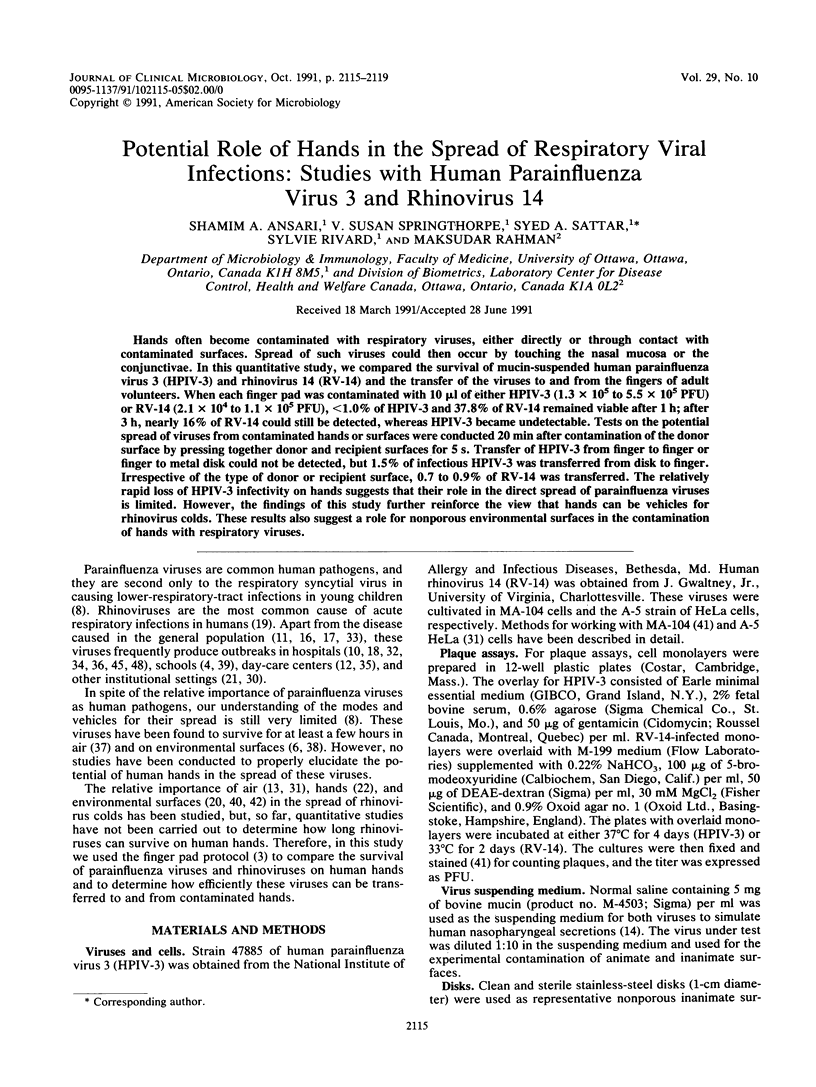
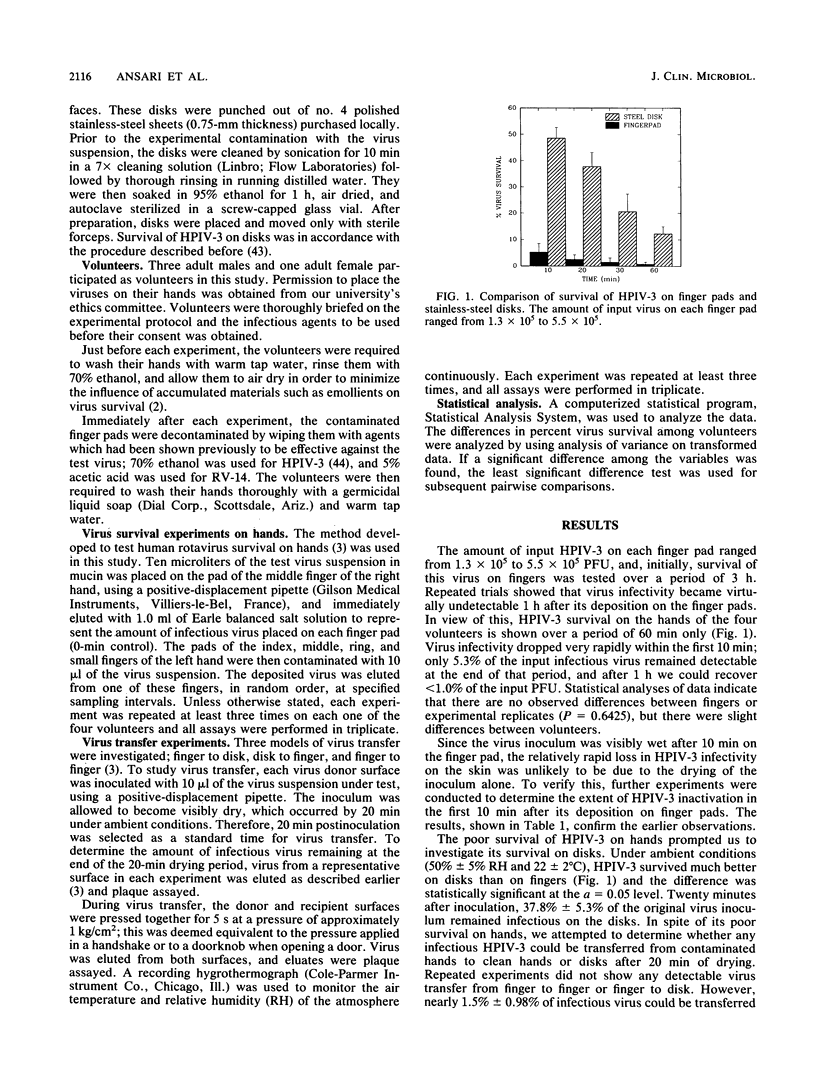
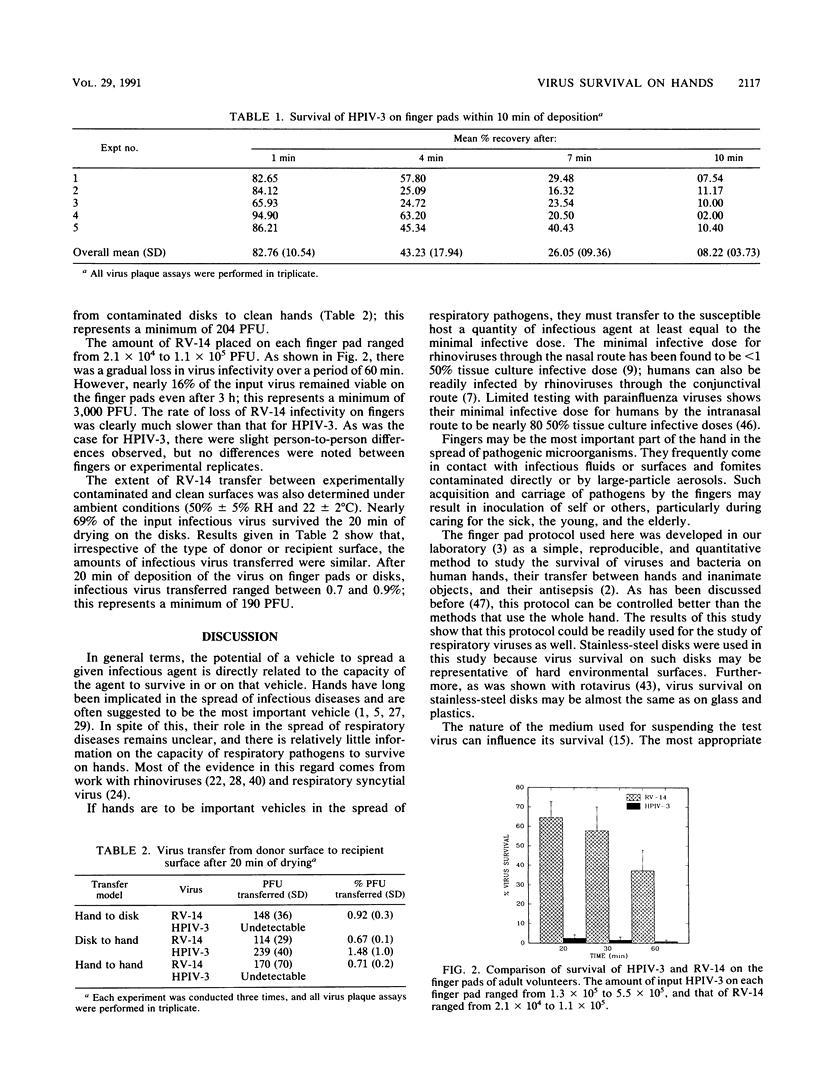
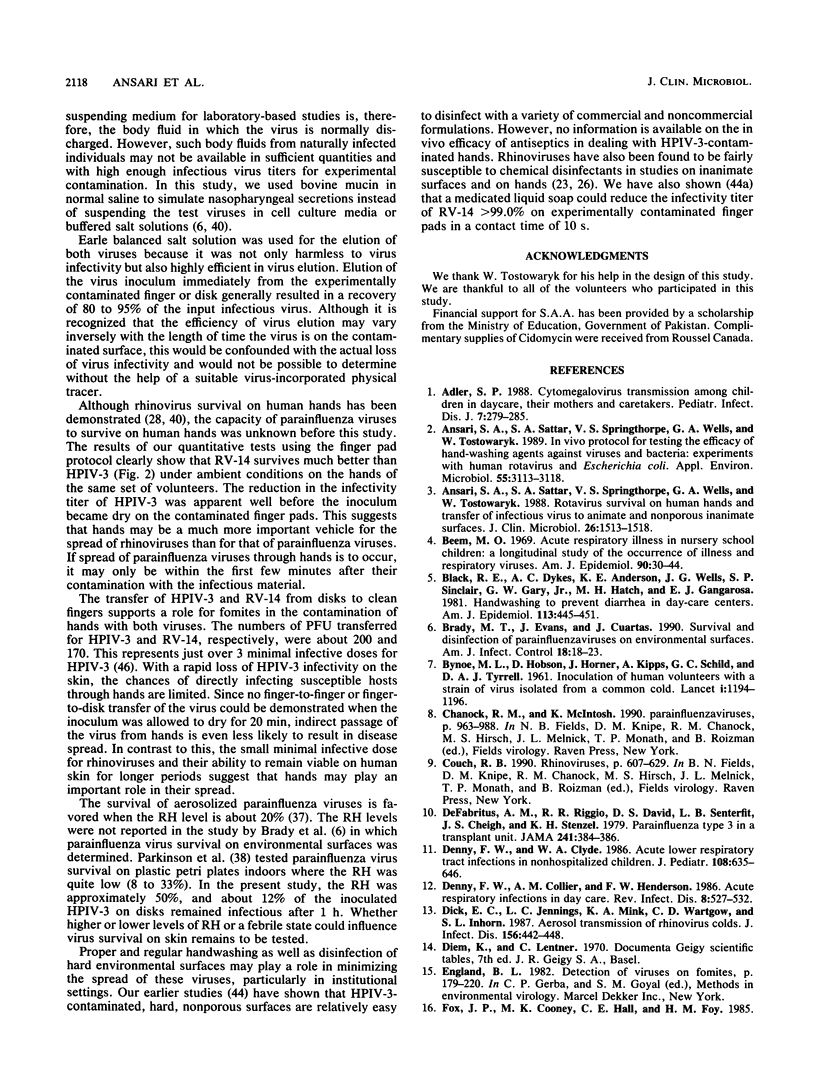
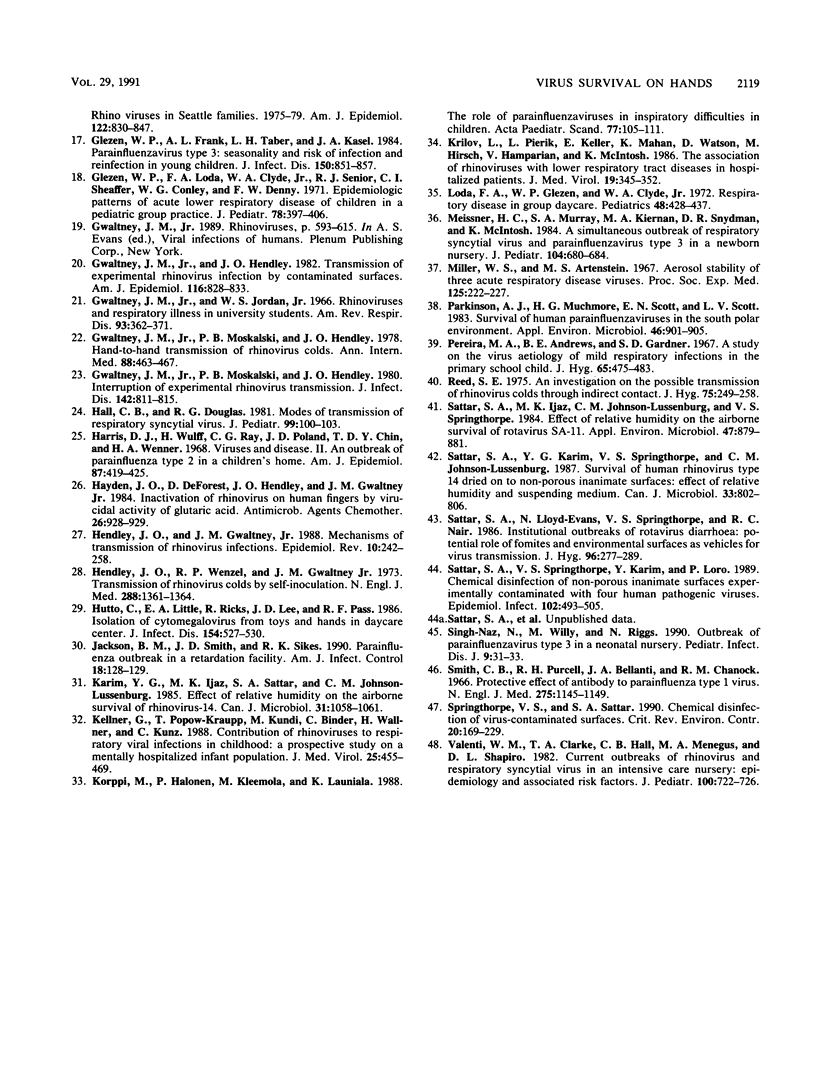
Selected References
These references are in PubMed. This may not be the complete list of references from this article.
- Adler S. P. Cytomegalovirus transmission among children in day care, their mothers and caretakers. Pediatr Infect Dis J. 1988 Apr;7(4):279–285. doi: 10.1097/00006454-198804000-00009. [DOI] [PubMed] [Google Scholar]
- Ansari S. A., Sattar S. A., Springthorpe V. S., Wells G. A., Tostowaryk W. In vivo protocol for testing efficacy of hand-washing agents against viruses and bacteria: experiments with rotavirus and Escherichia coli. Appl Environ Microbiol. 1989 Dec;55(12):3113–3118. doi: 10.1128/aem.55.12.3113-3118.1989. [DOI] [PMC free article] [PubMed] [Google Scholar]
- Ansari S. A., Sattar S. A., Springthorpe V. S., Wells G. A., Tostowaryk W. Rotavirus survival on human hands and transfer of infectious virus to animate and nonporous inanimate surfaces. J Clin Microbiol. 1988 Aug;26(8):1513–1518. doi: 10.1128/jcm.26.8.1513-1518.1988. [DOI] [PMC free article] [PubMed] [Google Scholar]
- BYNOE M. L., HOBSON D., HORNER J., KIPPS A., SCHILD G. C., TYRRELL D. A. Inoculation of human volunteers with a strain of virus isolated from a common cold. Lancet. 1961 Jun 3;1(7188):1194–1196. doi: 10.1016/s0140-6736(61)91941-9. [DOI] [PubMed] [Google Scholar]
- Black R. E., Dykes A. C., Anderson K. E., Wells J. G., Sinclair S. P., Gary G. W., Jr, Hatch M. H., Gangarosa E. J. Handwashing to prevent diarrhea in day-care centers. Am J Epidemiol. 1981 Apr;113(4):445–451. doi: 10.1093/oxfordjournals.aje.a113112. [DOI] [PubMed] [Google Scholar]
- Brady M. T., Evans J., Cuartas J. Survival and disinfection of parainfluenza viruses on environmental surfaces. Am J Infect Control. 1990 Feb;18(1):18–23. doi: 10.1016/0196-6553(90)90206-8. [DOI] [PubMed] [Google Scholar]
- DeFabritus A. M., Riggio R. R., David D. S., Senterfit L. B., Cheigh J. S., Stenzel K. H. Parainfluenza type 3 in a transplant unit. JAMA. 1979 Jan 26;241(4):384–386. [PubMed] [Google Scholar]
- Denny F. W., Clyde W. A., Jr Acute lower respiratory tract infections in nonhospitalized children. J Pediatr. 1986 May;108(5 Pt 1):635–646. doi: 10.1016/s0022-3476(86)81034-4. [DOI] [PubMed] [Google Scholar]
- Denny F. W., Collier A. M., Henderson F. W. Acute respiratory infections in day care. Rev Infect Dis. 1986 Jul-Aug;8(4):527–532. doi: 10.1093/clinids/8.4.524. [DOI] [PubMed] [Google Scholar]
- Dick E. C., Jennings L. C., Mink K. A., Wartgow C. D., Inhorn S. L. Aerosol transmission of rhinovirus colds. J Infect Dis. 1987 Sep;156(3):442–448. doi: 10.1093/infdis/156.3.442. [DOI] [PubMed] [Google Scholar]
- Glezen W. P., Frank A. L., Taber L. H., Kasel J. A. Parainfluenza virus type 3: seasonality and risk of infection and reinfection in young children. J Infect Dis. 1984 Dec;150(6):851–857. doi: 10.1093/infdis/150.6.851. [DOI] [PubMed] [Google Scholar]
- Glezen W. P., Loda F. A., Clyde W. A., Jr, Senior R. J., Sheaffer C. I., Conley W. G., Denny F. W. Epidemiologic patterns of acute lower respiratory disease of children in a pediatric group practice. J Pediatr. 1971 Mar;78(3):397–406. doi: 10.1016/s0022-3476(71)80218-4. [DOI] [PubMed] [Google Scholar]
- Gwaltney J. M., Jr, Hendley J. O. Transmission of experimental rhinovirus infection by contaminated surfaces. Am J Epidemiol. 1982 Nov;116(5):828–833. doi: 10.1093/oxfordjournals.aje.a113473. [DOI] [PubMed] [Google Scholar]
- Gwaltney J. M., Jr, Moskalski P. B., Hendley J. O. Hand-to-hand transmission of rhinovirus colds. Ann Intern Med. 1978 Apr;88(4):463–467. doi: 10.7326/0003-4819-88-4-463. [DOI] [PubMed] [Google Scholar]
- Gwaltney J. M., Jr, Moskalski P. B., Hendley J. O. Interruption of experimental rhinovirus transmission. J Infect Dis. 1980 Dec;142(6):811–815. doi: 10.1093/infdis/142.6.811. [DOI] [PubMed] [Google Scholar]
- Hall C. B., Douglas R. G., Jr Modes of transmission of respiratory syncytial virus. J Pediatr. 1981 Jul;99(1):100–103. doi: 10.1016/s0022-3476(81)80969-9. [DOI] [PubMed] [Google Scholar]
- Harris D. J., Wulff H., Ray C. G., Poland J. D., Chin T. D., Wenner H. A. Viruses and disease. II. An outbreak of parainfluenza Type 2 in a children's home. Am J Epidemiol. 1968 Mar;87(2):419–425. doi: 10.1093/oxfordjournals.aje.a120832. [DOI] [PubMed] [Google Scholar]
- Hayden G. F., Deforest D., Hendley J. O., Gwaltney J. M., Jr Inactivation of rhinovirus on human fingers by virucidal activity of glutaric acid. Antimicrob Agents Chemother. 1984 Dec;26(6):928–929. doi: 10.1128/aac.26.6.928. [DOI] [PMC free article] [PubMed] [Google Scholar]
- Hendley J. O., Gwaltney J. M., Jr Mechanisms of transmission of rhinovirus infections. Epidemiol Rev. 1988;10:243–258. [PubMed] [Google Scholar]
- Hendley J. O., Wenzel R. P., Gwaltney J. M., Jr Transmission of rhinovirus colds by self-inoculation. N Engl J Med. 1973 Jun 28;288(26):1361–1364. doi: 10.1056/NEJM197306282882601. [DOI] [PubMed] [Google Scholar]
- Hutto C., Little E. A., Ricks R., Lee J. D., Pass R. F. Isolation of cytomegalovirus from toys and hands in a day care center. J Infect Dis. 1986 Sep;154(3):527–530. doi: 10.1093/infdis/154.3.527. [DOI] [PubMed] [Google Scholar]
- Jackson B. M., Smith J. D., Sikes R. K. Parainfluenza outbreak in retardation facility. Am J Infect Control. 1990 Apr;18(2):128–129. doi: 10.1016/0196-6553(90)90093-8. [DOI] [PubMed] [Google Scholar]
- Karim Y. G., Ijaz M. K., Sattar S. A., Johnson-Lussenburg C. M. Effect of relative humidity on the airborne survival of rhinovirus-14. Can J Microbiol. 1985 Nov;31(11):1058–1061. doi: 10.1139/m85-199. [DOI] [PubMed] [Google Scholar]
- Kellner G., Popow-Kraupp T., Kundi M., Binder C., Wallner H., Kunz C. Contribution of rhinoviruses to respiratory viral infections in childhood: a prospective study in a mainly hospitalized infant population. J Med Virol. 1988 Aug;25(4):455–469. doi: 10.1002/jmv.1890250409. [DOI] [PubMed] [Google Scholar]
- Korppi M., Halonen P., Kleemola M., Launiala K. The role of parainfluenza viruses in inspiratory difficulties in children. Acta Paediatr Scand. 1988 Jan;77(1):105–111. doi: 10.1111/j.1651-2227.1988.tb10607.x. [DOI] [PubMed] [Google Scholar]
- Krilov L., Pierik L., Keller E., Mahan K., Watson D., Hirsch M., Hamparian V., McIntosh K. The association of rhinoviruses with lower respiratory tract disease in hospitalized patients. J Med Virol. 1986 Aug;19(4):345–352. doi: 10.1002/jmv.1890190407. [DOI] [PubMed] [Google Scholar]
- Loda F. A., Glezen W. P., Clyde W. A., Jr Respiratory disease in group day care. Pediatrics. 1972 Mar;49(3):428–437. [PubMed] [Google Scholar]
- Meissner H. C., Murray S. A., Kiernan M. A., Snydman D. R., McIntosh K. A simultaneous outbreak of respiratory syncytial virus and parainfluenza virus type 3 in a newborn nursery. J Pediatr. 1984 May;104(5):680–684. doi: 10.1016/s0022-3476(84)80943-9. [DOI] [PubMed] [Google Scholar]
- Miller W. S., Artenstein M. S. Aerosol stability of three acute respiratory disease viruses. Proc Soc Exp Biol Med. 1967 May;125(1):222–227. doi: 10.3181/00379727-125-32054. [DOI] [PubMed] [Google Scholar]
- Parkinson A. J., Muchmore H. G., Scott E. N., Scott L. V. Survival of human parainfluenza viruses in the South Polar environment. Appl Environ Microbiol. 1983 Oct;46(4):901–905. doi: 10.1128/aem.46.4.901-905.1983. [DOI] [PMC free article] [PubMed] [Google Scholar]
- Pereira M. S., Andrews B. E., Gardner S. D. A study on the virus aetiology of mild respiratory infections in the primary school child. J Hyg (Lond) 1967 Dec;65(4):475–483. doi: 10.1017/s0022172400046015. [DOI] [PMC free article] [PubMed] [Google Scholar]
- Reed S. E. An investigation of the possible transmission of Rhinovirus colds through indirect contact. J Hyg (Lond) 1975 Oct;75(2):249–258. doi: 10.1017/s0022172400047288. [DOI] [PMC free article] [PubMed] [Google Scholar]
- Sattar S. A., Ijaz M. K., Johnson-Lussenburg C. M., Springthorpe V. S. Effect of relative humidity on the airborne survival of rotavirus SA11. Appl Environ Microbiol. 1984 Apr;47(4):879–881. doi: 10.1128/aem.47.4.879-881.1984. [DOI] [PMC free article] [PubMed] [Google Scholar]
- Sattar S. A., Karim Y. G., Springthorpe V. S., Johnson-Lussenburg C. M. Survival of human rhinovirus type 14 dried onto nonporous inanimate surfaces: effect of relative humidity and suspending medium. Can J Microbiol. 1987 Sep;33(9):802–806. doi: 10.1139/m87-136. [DOI] [PubMed] [Google Scholar]
- Sattar S. A., Lloyd-Evans N., Springthorpe V. S., Nair R. C. Institutional outbreaks of rotavirus diarrhoea: potential role of fomites and environmental surfaces as vehicles for virus transmission. J Hyg (Lond) 1986 Apr;96(2):277–289. doi: 10.1017/s0022172400066055. [DOI] [PMC free article] [PubMed] [Google Scholar]
- Sattar S. A., Springthorpe V. S., Karim Y., Loro P. Chemical disinfection of non-porous inanimate surfaces experimentally contaminated with four human pathogenic viruses. Epidemiol Infect. 1989 Jun;102(3):493–505. doi: 10.1017/s0950268800030211. [DOI] [PMC free article] [PubMed] [Google Scholar]
- Singh-Naz N., Willy M., Riggs N. Outbreak of parainfluenza virus type 3 in a neonatal nursery. Pediatr Infect Dis J. 1990 Jan;9(1):31–33. doi: 10.1097/00006454-199001000-00007. [DOI] [PubMed] [Google Scholar]
- Smith C. B., Purcell R. H., Bellanti J. A., Chanock R. M. Protective effect of antibody to parainfluenza type 1 virus. N Engl J Med. 1966 Nov 24;275(21):1145–1152. doi: 10.1056/NEJM196611242752101. [DOI] [PubMed] [Google Scholar]
- Valenti W. M., Clarke T. A., Hall C. B., Menegus M. A., Shapiro D. L. Concurrent outbreaks of rhinovirus and respiratory syncytial virus in an intensive care nursery: epidemiology and associated risk factors. J Pediatr. 1982 May;100(5):722–726. doi: 10.1016/s0022-3476(82)80571-4. [DOI] [PubMed] [Google Scholar]


